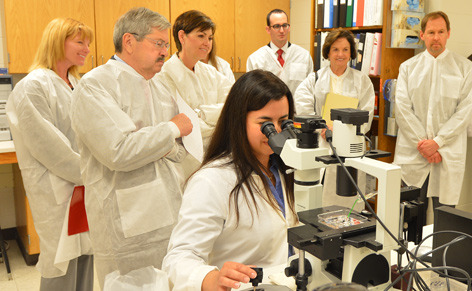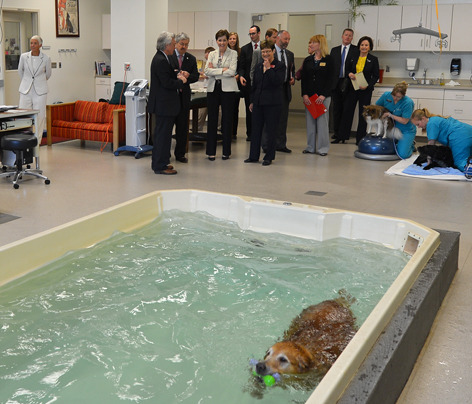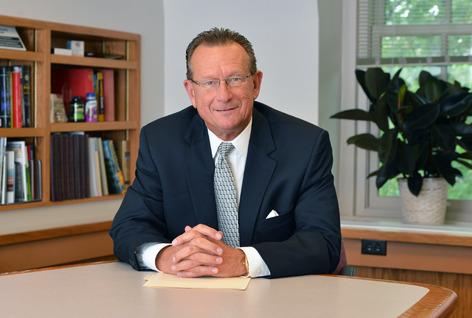Something's brewing

Alex Egeland, a tree trimmer in facilities planning and management, submitted this image to ISU Photostream following stormy weather that moved through the area Monday evening. He used a high dynamic range (HDR) imaging technique, capturing the impressive storm clouds and marrying it to a shot of the campanile taken a short time later.
Governor visits Veterinary Medicine facilities

Interested observers watch a bacteriology laboratory computer screen as faculty member Marianna Jahnke takes a biopsy from a bovine embryo for genetic testing. Observing (from left) are president of the Iowa Veterinary Medical Association Jodie Pettit, Gov. Terry Branstad, Lt. Gov. Kim Reynolds, Board of Regents state relations officer Joe Murphy, governor's executive assistant Margaret Hough and senior vice president and provost Jonathan Wickert. Photo by Bob Elbert.
Iowa Gov. Terry Branstad stopped by the College of Veterinary Medicine to tour facilities and proclaim 2013 the Year of the Veterinarian.
ISU's College of Veterinary Medicine is the oldest public veterinary school in the nation. Since its creation in 1879, it has produced more than 7,000 veterinarians. The gubernatorial proclamation recognizes Iowa’s veterinarians for their contributions to animal and human health.
Among those joining Branstad on a tour of the small and large animal hospitals and the Veterinary Diagnostic Lab were Lt. Gov. Kim Reynolds, president Steven Leath, senior vice president and provost Jonathan Wickert, dean of the Veterinary Medicine college Lisa Nolan, and president of the Iowa Veterinary Medical Association Jodie Pettit.

At the Canine Rehabilitation Center, the governor's group watches several dogs engaged in therapeutic workouts. Photo by Bob Elbert.
Class of 2013 boosts scholarship fund
Last year's graduating seniors passed over more typical class gift options -- such as benches, plaques, art work -- choosing instead to leave some scholarship cash for fellow students.
That scholarship fund got a big boost recently when the Class of 2013 decided to direct its gift to the same place.
"We talked about the benefits of a continuing endowment with the leaders of the Senior Class Council, and they were immediately on board," said Mary Evanson, director of annual and special gifts for the ISU Foundation.
Thus far, nearly 400 members of the Class of 2013 have pledged more than $30,000 to the scholarship fund. Evanson expects that number to grow, as student fundraisers continue making calls to the senior class. Last year's class pledged $45,400.
An endowment must reach a $25,000 minimum before scholarships may be awarded, Evanson said. She anticipates that level will be attained soon, as the current class pays on its pledges. The award on a $25,000 endowment is about $1,200 annually.
The Senior Class Gift Scholarship fund will provide scholarships for students who have reached their senior year at Iowa State. There aren't as many scholarships available to seniors as other students, Evanson explained. ISU's financial aid office will determine how the scholarship funds will be allocated.
"The generosity of the Class of 2012 and 2013 is incredible and speaks volumes about how important scholarship funding is to our students," Evanson added. "Seniors giving back to their alma mater to help other students -- it’s philanthropy in its truest form and it is inspiring to see so many recent graduates get involved."
Five questions for the entrepreneur in residence

ISURF entrepreneur in residence Kurt Heiar. Photo by Bob Elbert.
Entrepreneur in residence Kurt Heiar ("Hire") is the first to tell you he's not a one-man band, and that a variety of programs and efforts focusing on entrepreneurialism thrive at Iowa State. The intent is that his experience as a private sector CEO and entrepreneur will assist university efforts to move technology into the marketplace and create jobs for Iowans. No two days are the same for Heiar, but his activities at the university include:
- Assist faculty and researchers – both those who are savvy about entrepreneurialism and want to get involved and those who "fear they don't have time for what they perceive as a daunting undertaking"
- Build databases of investor, state and corporate contacts who will assist ISU companies
- Help young ISU-affiliated companies and fledgling entrepreneurs overcome problems to keep them moving forward
- Present guest lectures to classes and student organizations
- Review existing technologies at ISU and help determine which have business viability
The Basics
Name: Kurt Heiar
Position: Half-time entrepreneur in residence for the ISU Research Foundation (ISURF), and CEO of multiple early-stage companies since 1998
Months at ISU: 9
Office: 310 Lab of Mechanics, 4-4740
To successfully introduce a product or service into the marketplace, how important is timing?
It's important from the standpoint of investors. Investors like to get into the "hot" technologies or disciplines much more readily than an area where they feel the train has left the station. Some investors like to be in a deal very early, while others prefer late-stage projects when the risk is reduced a bit more. So timing relates to those options.
It [timing] also is important if there are too many established companies too far down the line in their development that catching up is going to be difficult or terribly expensive.
Is entrepreneurialism best left to people who function well on three hours of sleep?
The resources are flourishing because there's such an interest in entrepreneurialism. Disciplines that used to be very un-entrepreneurial are becoming much more that way. Conferences for engineers or veterinarians often have a division that's called innovation or entrepreneurialism -- or both.
So, the misperception that it's too much for me to tackle can be addressed very effectively. For example, there are entrepreneurial CEOs who are very good and who, for a slice of the pie, are willing to step in and lead the organization for a while. Most early-stage startups don't require a 40-hour-per-week executive. Savvy boards can be put in place to show people shortcuts to take. There's a lot of outsourcing that can be done.
"My big-picture goal is to help drive that whole research and economic development process so our inventions and innovation can address real world needs, across as many disciplines as possible. The more I can help put new ideas and potential new companies into the funnel for refinement and evaluation, the more I'm helping an important segment of the mission of this university."
— Kurt Heiar
How big is luck's role in entrepreneurial success?
Increasingly we're seeing that entrepreneurialism is a discipline like any other academic pursuit. To be successful as an entrepreneur is not unlike trying to be a veterinarian without going to vet school. It's pretty tough, to say the least. You need to know how to read financial statements, how to do market research, what are realistic milestones for getting capital and much more.
Most successful entrepreneurs become serial entrepreneurs. It's a bug and if they get it -- and especially if they're successful -- very often they're hunting around for the next opportunity.
Is it more difficult to succeed in Iowa?
A great idea with some intellectual property protection around it typically can succeed anywhere. The only area we tend to suffer – not just Iowa, but some of the Midwestern states when it comes to business in general – is access to capital. You can raise up to a certain amount of money in Iowa, and more early-stage capital sources are emerging here. As company needs grow, the circle typically expands to investors who are regional – St. Louis or Minneapolis or Chicago. Beyond that you're looking at the coasts.
More than anything, it's the numbers of investors or networks. You can go to New York or Boston and probably pitch your company to seven or eight interested investor networks in a day -- and may not get in a taxi to do it. In Iowa, you may pitch to two, and one may be in Des Moines and one may be in the Quad Cities. Although, as I mentioned, things are changing for the better in Iowa.
Does starting something new have to be exhausting?
The newer approaches [to entrepreneurialism] build in flexibility. So, you are iterating and pivoting as you go because it is so critical to talk to customers very early on and discover who that customer is and validate your assumptions. Our markets move so fast, things change so fast; you've got to stay on top of that.
Not everyone does it that way, but studies indicate you can significantly increase your chances of success because you're not stuck on a wrong path. You don't want to be 2.5 years down the road and discover you totally misguessed the product or the service the customer wants. You need to know that through the whole process.
Extension and Outreach strategic initiatives receive funding
Seven proposals received one-time funding totaling approximately $1.4 million in the second year of the Vice President for Extension and Outreach's Strategic Initiatives program. The initiatives were selected through a competitive process that is open to faculty and staff, including ISU Extension and Outreach county staff, and county extension councils.
Vice president Cathann Kress considered proposals that would strengthen the overall portfolio of Extension and Outreach in one of four signature areas: economic development, food and the environment, K-12 youth outreach or health and well-being. Funded initiatives are innovative large-scale projects that Extension and Outreach units or staff otherwise would not be able to accomplish. They are intended to connect Iowa State's colleges to Iowans.
The proposals selected this spring are:
- Destination STEM, which will provide infrastructure to connect ISU faculty, staff, research and programs with the K-12 community for program development and delivery
- Rising Star internship program, which will provide multidisciplinary internships in rural Iowa for ISU students to educate them about local career opportunities after graduation
- Communicating Economic Impact, which will strengthen the development of external stakeholder partnerships in the area of economic development
- Data Infrastructure, which will enhance the capacity for staff and clients to use key Iowa data for better-informed decision making, particularly to help make communities fiscally sustainable
- Consumer Centered Crops, which will develop unified websites about crop production for use by farmers, agronomists and others seeking unbiased, research-based information
- Local Food Systems, which will strengthen campus-county connections to improve and integrate local programming in the areas of horticulture, food production and food entrepreneurship
- Bridging the Gap, which will use business assistance specialists, county extension units and student learning teams from the Design and Human Sciences colleges to link entrepreneurial education, outreach and economic development in rural communities
More information about the 2013 initiatives, as well as progress reports on the initiatives selected a year ago, is available in Kress' "See You There" blog.
In the spring of 2012, the first year of the program, seven proposals received funding totaling nearly $1.3 million.
Parking and road closures begin May 23 for Special Olympics
Iowa State, which has served as the host site for the Iowa Special Olympics Summer Games since 1984, will welcome athletes, coaches, parents and volunteers back to campus Thursday through Saturday, May 23-25.
An estimated 2,700 athletes from around the state will compete at university venues in bocce, cycling, developmental sports, soccer, tennis, swimming and track and field events. More than 1,400 coaches/chaperones and 2,000 volunteers also will participate.
Other activities include a festival, sports clinics, cheerleading clinic and the healthy athlete program. Iowa State men's basketball player Melvin Ejim will serve as honorary chair of the games, declaring the games open at Thursday's ceremony (7 p.m., Hilton Coliseum).
Numerous recreation facilities across campus will serve as sports venues, including Beyer Hall, Forker Building, Lied Center and the Iowa State Center parking lots. Access to some roads and parking lots will be limited or closed, including:
Road closures
- Beach Road: Closed to through traffic from Lincoln Way to Wallace Road Thursday and Friday (7:30 a.m.-10 p.m. daily) 


- South Fourth Street: Closed from Beach Avenue to just west of entrance to stadium parking lots on Thursday (8 a.m.-5 p.m.) for bike race events. 


Parking lot changes
- Iowa State Center lots, Thursday (12:01 a.m.-5 p.m.): All lots will be closed for bike race events. Commuter parking will move to the stadium parking lots for Thursday and Friday, and CyRide will be routed through lots S3-S8.
- Lot 3 (north side of Beyer Hall), Friday (all day): Open to Lot 3 24-hour Reserve, Special Olympics or handicap permit holders. 


- Lots 57 and 100 (west and south sides of Lied Center), Thursday and Friday (all day): Open to Lot 57 Reserve or Special Olympics permit holders. 


- Lot 50A (west side of Forker Building), Thursday and Friday (all day): Open to Special Olympics or handicap permit holders.
- Richardson Court residence area (all parking stalls), Thursday and Friday (all day): Open to Special Olympics or handicap permit holders.
